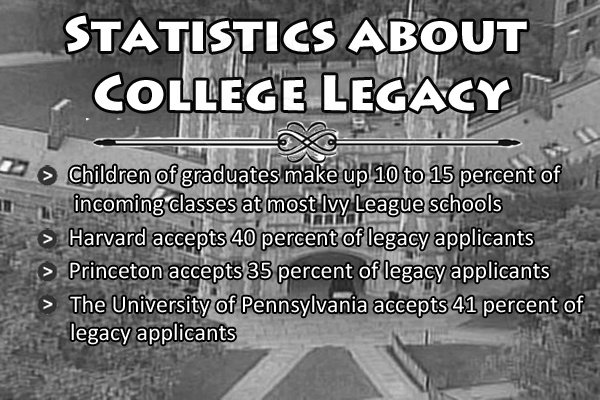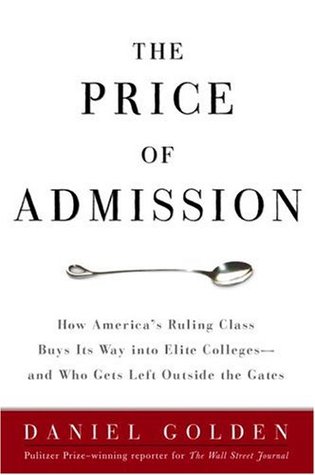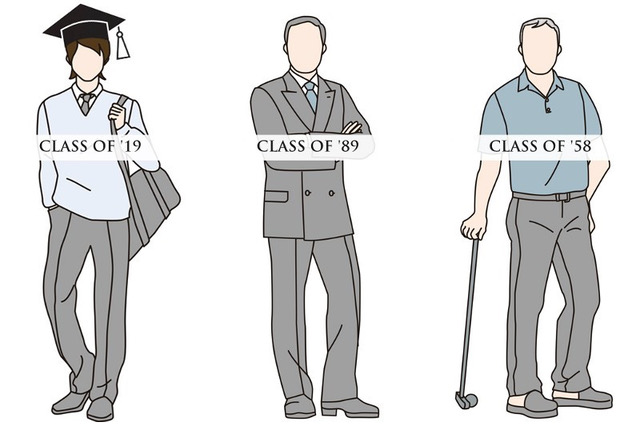
Turnabout being fair play, we’re going to upend the kaleidoscope and view U.S. higher education from the lens of the rich and powerful. Recently we turned the spotlight on the seventy percent of college students in the empire who require one or more student loans to complete their degree only to wind up among the forty-four million ex-students in debt servitude owing $1.5 trillion. If you missed it, check out In the U.S. You Have To Be a One Percenter To Afford College: Not in the Rest of the World
Living in another world are the alumni from highly select colleges and universities whose problems do not run to the mundane like how they’re going to pay for little Susie’s college education. Oh my no, these fat cats have a gilt-edged security blanket — “legacy preference” (given by a college or university to certain applicants on the basis of their relationship to alumni of that institution). The world outside gated communities skips the euphemism and cuts to the chase, describing legacy preference as affirmative action for the rich. According to U.S. News and World Report, in 75% of what the magazine identified as the top 100 U.S. colleges and universities, legacy preference takes a big bite out of what should be (but isn’t) a fair and impartial admissions process. Never shy about going to rhetorical heights to make lemonade out of what the rest of the world considers lemons, here’s how two university presidents put a smiley-face on this racket. Princeton’s president substitutes weasel words for logic to make the case for legacy preference — “a recognition of a special bond that Princeton has with its alumni and it matters so much to the University.” Crying towel, anyone? In the “can you beat that” department, the ex-president of George Washington University produced one of the most laughably insincere and incoherent op-eds to grace the editorial page of The New York Times — “…the accommodation of a limited number of youngsters whose parents, grandparents and great grandparents helped to lay the foundation on which the institution stands shows a respect for tradition and honors those without whom the contemporary university might not even exist.”
What in blazes are legacy admissions to the most prestigious colleges doing in the land of equal opportunity (you know the America you’re asked to honor with your hand over your heart at your daughter’s sixth grade soccer game)? Would it surprise you to learn that elites in colonial America had the same bright idea about keeping their sons (daughters were out of the loop, not admitted to Yale until 1969) separated from the “riff-raff?” Their sons went to private prep schools, then as now, a pipeline to elite higher education. No coincidence that the demand for elite education institutions among America’s wealthiest families spurred the founding in the colonial period of Harvard (1636), Yale (1701), Princeton (1736) and most of the other “Ivies.” Up until the 1920s, prestigious universities tended to pick only the most academically qualified candidates. (Those of a lesser social caste wouldn’t have dreamed of applying). Three hundred years later, the bottom dropped out of the world of the affluent. As the great wave of immigration began in 1880 and extended through 1920, twenty-five million pulled up stakes in their home countries and came to America. The overwhelming majority were ethnic and religious minorities, predominantly Italians, Poles, Jews, and Slavs. In this crowded space, legacy admissions became the answer to a prayer for pampered elites. Horror of horrors, if academic excellence remained the criterion for admission, students with the “proper pedigree” and undistinguished academic records might lose what they and their parents considered their rightful place to more qualified outsiders (overwhelmingly Jewish).
The Ivies were the first to latch onto this exclusionary maneuver. But first a little window dressing was in order. Suddenly “character,” meaning white, male, rich, and Protestant muscled into the criteria for admission. In 1925, Yale announced it was giving first preference to “Yale sons of good character and reasonably good record…”
It didn’t take long for other colleges, bedeviled with a host of academically superior but socially “inappropriate” candidates, to climb on board the legacy preference bandwagon —including state-supported schools (University of Michigan), Catholic schools like Notre Dame (ironic since legacy admissions were in part a tactic to keep Catholics out of top-ranked schools) and highly selective non-Ivies (Stanford).

In an era of phony claims by politicians that rising inequality must be given “serious consideration” (like a “blue-ribbon” committee to study the problem), why are legacy admissions still an integral part of admission decisions at top U.S. universities? When the question is raised, a number of ludicrous, untrue, meaningless defenses take center stage. At Harvard, the patently ridiculous is spouted as gospel — legacy admissions produce a more “diverse array of talents, skills, and qualifications than test scores alone.” Anyone who thinks admitting a homogeneous group of rich, mostly white children of privileged backgrounds is producing a diversified student body is either living in a bubble or requires immediate medical attention. If that doesn’t wash, another pathetic defense of the indefensible rears its ugly head, this one by the communications director at Brown (it is not clear how long his nose grew after this whopper)— “When it comes down to choosing among equally strong candidates, one consideration can be the natural affinity…for the University…among children of alumni.” How clueless or deliberately myopic are these guys? Numerous studies (many of them conducted at the same universities rolling out the red carpet for legacy candidates) have pointed out that legacy preferences do not target those alumni children who are “equally qualified” with non-alumni children. In fact, the reverse is true. The whole point of legacy preference is to give privileged kids who are losing ground academically to first generation candidates a “leg-up”. One study of thirty highly selective colleges and universities found that the odds of candidates being admitted to the alma mater of one of their parents is — you ready for it — more than seven times better than the odds of non-alumni candidates. A study of another group of top schools concluded that alumni children are 45% more likely to be admitted than other non-alumni equally or more qualified candidates.
When all else fails, what’s left for the hard-driving college administrator but capitalism’s excuse for bad behavior — the profit motive. It goes like this: wealthy parents (and all top colleges truly believe their alumni have overflowing pots of gold stashed somewhere) will shower their alma mater with copious amounts of gelt in return for legacy admissions for their children. Once again, the facts prove them wrong. The percent of alumni who donate has dropped every year for the last ten years. What has saved the bacon of many outrageously priced universities is that fewer are giving more —way more. In 2015 alone, there were seven gifts of more than $100 million. In 2010, the Century Foundation published Affirmative Action for the Rich which ponted out that of seven institutions eliminating legacy preference between 1998-2007, none experienced any serious reduction in alumni giving.
Surely the presidents of Harvard, Yale and other selective universities know that the link between legacy preference and increased alumni giving is hooey. Perhaps to avoid annoying their alumni and risking their jobs, they continue to recruit legacy candidate with inducements like special legacy luncheons (not open to the great unwashed), admission workshops and early dorm move-in times. More likely, financial gain is not the only motive for the preferential treatment given to the rich and powerful. In the time-honored tradition of elites handing the baton of leadership to like-minded members of the next generation, they regard legacy admissions as a way of making sure enough of the “right” people get into the right schools and are able to climb the ladder to the top rungs of the economic, political and social apex of America’s oligarchy.
The good news is that they may not get away with it much longer. A band of first generation students at top colleges see through their hypocrisy — “At institutions of higher learning, there are people doing research on combatting income inequality [while admission officers in the same colleges are providing] affirmative action for the wealthy.” These young provocateurs are determined to make a difference. They work tirelessly to mount petition drives to confront school administrators with the unpopularity of legacies and coordinate with students at other colleges and universities to spread the word about how the legacy tradition demeans both the institution and its students. Their fondest hope —to publicly shame notoriously publicity-adverse elite institutions into eliminating this obnoxious perk. In 2018, supporters of the anti-legacy drive got heavyweight support from William Dudley, retiring president of the New York Federal Reserve— “[Legacy preferences] are patently unfair and scrapping such policies would increase social mobility.” (Note: Why is it that powerful men on their way out the door suddenly start telling the truth?)
When one first generation student at Cornell was asked why he opposed a system that his own children might one day benefit from, he answered with another question, one which strikes at the heart of the America we celebrate in ritual ceremonies but rarely see in action: “How do we extend the ladders of opportunity to other bright students from their communities who have been left behind?”

889 total views, 1 views today
